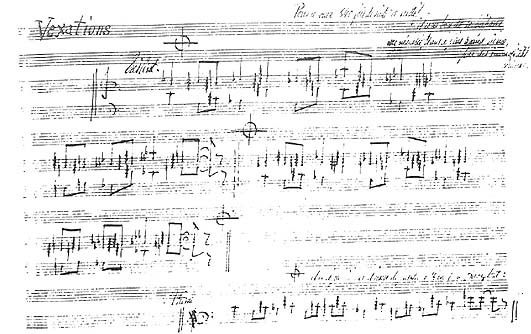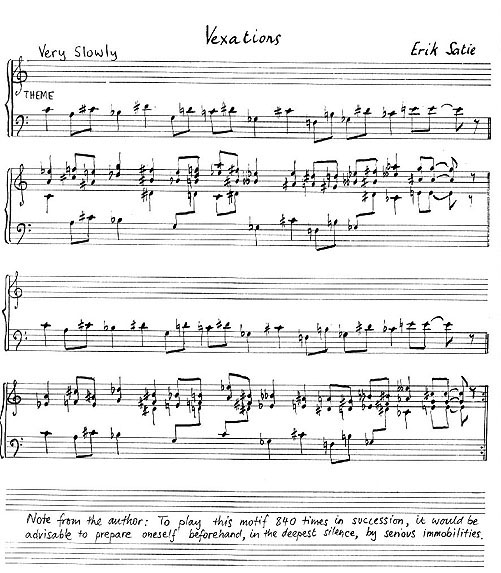There is also a psycho-biographical reading of Vexations, in which Satie,
tormented by conflicting desires of the spirit and the flesh, and deeply
disturbed by the disastrous course of his relationship with Suzanne Valadon,
exorcises his vexation in music. Imagine Satie sitting at the piano in his
tiny apartment (cupboard would be closer the truth) in the Rue Cortot playing
Vexations hour after hour, seeking spiritual solace - a kind of musical
psychotherapy, perhaps. This interpretation is supported by the closely
related Danses gothiques, which Satie describes as a kind of religious office
"for the the greater calm and tranquillity of my soul", written, as the
first dance states, "in a time of great suffering." But laughter may be
the most effective psychotherapy of all. Humour can be construed in the
title which, by means of letter substitution, transforms the classical theme
and variations form into a theme and vexations.11 And, notwithstanding Cage, the performance instructions themselves conceivably
have an ironic tone. It is typical of Satie that the very words which make
Vexations one of his most radical works also cast doubt on the seriousness
of the piece. One cannot parody Vexations : it is so bizarre that it is
already a parody of itself. Parody is characteristic of Satie's work, and
self-parody in particular. It goes beyond a self-mocking expression of Satie's
characteristic modesty and is elevated to an artistic method. Satie's humour
has been variously interpreted as a smoke-screen for his own technical inadequacies,
a Dadaist anti-Art gesture, the practical jokery of an incorrigible fumiste,
or a means of maintaining a stance of ironic detachment from the spiritual
crises of his time.12
There may be some truth in all of these, but they only partial explanations
of an art in which sense and nonsense, seriousness and humour, mystery and
mystification co-exist. Perhaps Satie sought to transcend such dualities,
going 'beyond sense and nonsense' as Nietzsche and the Zen masters sought
to go 'beyond good and evil.' Whatever Vexations may have meant to Satie,
its meaning is now inseparable from the significance it has acquired through
the efforts of John Cage, whose devotion to Satie's music began in the late
1940's and continued to the end of his life. From 6pm on 9 September, 1963,
to 12.40 pm the next day, Cage staged the first complete performance of
Vexations, using a team of ten pianists (with two reserves) working in shifts,
playing all 840 repetitions without a break. It lasted 18 hours 40 minutes,
and was covered by eight critics from the New York Times, working in two-hour
relays. The first Australian performance, organised by David Ahern, took
place in Watters Gallery, Darlinghurst, Sydney, on 21-2 February 1970. The
performance lasted 22 hours; the pianist was Peter Evans, who attempted
the performance solo. After 16 hours, having reached repetition 595, he
stopped abruptly, and left the room. He wrote: "I would not play the piece
again. I felt each repetition slowly wearing my mind away. I had to stop.
...People who play it do so at their own great peril." Apparently his mind
became full of "evil thoughts, [and] animals and "things" started peering
out of the score at him." However all was not lost; another pianist, Linda
Wilson, came forward and completed the performance, reporting no ill effects.13
The act of performing or listening to a complete performance of Vexations
cannot be compared to any other musical experience. As Cage observed, "the
experience over the 18 hours and 40 minutes of those repetitions was very
different from the thought of them or the realisation that they were going
to happen. For them to actually happen, to actually live through it, was
a different thing. What happened was that we were very tired, naturally,
after that length of time and I drove back to the country...I slept an unusually
long period of time, and when I woke up, I felt different than I had ever
felt before. And furthermore the environment that I looked out upon looked
unfamiliar even though I had been living there. In other words, I had changed
and the world had changed...It wasn't an experience I alone had, but other
people who had been in it wrote to me or called me up and said that they
had had the same experience." 14 From the audience point of view, Dick Higgins observed, "the music first
becomes so familiar that it seems extremely offensive and objectionable.
But after that the mind slowly becomes incapable of taking further offence,
and a very strange euphoric acceptance and enjoyment begin to set in...Is
it boring? Only at first. After a while the euphoria...begins to intensify.
By the time the piece is over, the silence is absolutely numbing, so much
of an environment has the piece become."15 In Cage's famous aphorism, "In Zen they say: If something is boring after
two minutes, try it for four. If still boring, try it for eight, sixteen,
thirty-two, and so on. Eventually one discovers that it's not boring at
all but very interesting." 16 In a poetic sense,Vexations never finishes - the 840 repetitions are themselves
but an instant in the eternal present in which the music exists like some
Platonic form, obliterating memory, eluding analysis. In the words of an
ancient Indian saying, "The music continues; it is we who walk away."
Erik Satie: A selective chronology of his life
1866 Birth of Eric [sic] Alfred Leslie Satie, 9am, May 17 in Honfleur.
1884 First extant composition, Allegro for piano.
1886 January: Piano examination at Paris Conservatoire. Examiner's comments:
"Insignificant and laborious." June: Piano examination at Paris Conservatoire.
Examiner's comment: "Worthless."
1888 Composes 3 Gymnopédies . Engaged as pianist at the Montmartre cabaret "Le
Chat Noir".
1890 Meets Joséphin Péladan, "Sâr" of the Order of the Catholic Rosy Cross,
the Temple and the Grail. 1892 Presents candidacy to the French Academy
of Fine Arts. Candidacy unsuccessful.
1893 Liaison with painter Suzanne Valadon. Founds the Metropolitan Church of
Art of Jesus, Leader. Composes Vexations .
1894 Presents second candidacy to the French Academy of Fine Arts. Candidacy
unsuccessful.
1895 Using a small inheritance, purchases seven identical suits of grey velvet
corduroy. Nicknamed "The Velvet Gentleman."
1896 Presents third candidacy to the French Academy of Fine Arts. Candidacy
unsuccessful.
1898 Moves to apartment (formerly inhabited by the tramp Bibi-la- Purée) at
No.22, rue Cauchy, in Arcueil-Cachan, a working class suburb of Paris.
1903 Composes Three Pieces in the Shape of a Pear .
1904 Public brawl with the critic "Willy" (sometime husband of novelist Colette)
at a concert.
1905 Enrols at the Schola Cantorum to study counterpoint.
1913 Writes the absurdist drama Medusa's Trap , with music "by the same gentleman."
Beginning of Satie's 'humorous' period.
1914 Assassination of Socialist leader Jean Jaures (July 31). Satie joins Socialist
Party (August 1).
1917 Premiere of Parade by Diaghilev's Russian Ballet, music by Satie, scenario
by Jean Cocteau, design by Pablo Picasso. Sued for defamation by critic
Jean Poueigh.
1921 Joins Communist Party. 1922 Chairman of the First Dada Congress of Paris.
1924 Collaborates with Francis Picabia on the ballet Relache , which includes
music for Renée Clair's film Entr'Acte, shown between acts.
1925 Death of Satie from cirrhosis of the liver (July 1).
Notes
1. John Cage, Silence (Middletown, Conn.: Wesleyan University Press, 1961),
78.
2. According to the painter Santiago Rusi–ol, in Ornella Volta, Erik Satie
ˆ Montmartre, (Paris, Musée de Montmarte, 1982).
3. Alan M. Gillmor, Erik Satie (New York, W.W. Norton & Co., 1988), 103.
4. Gavin Bryars, 'Vexations' and its Performers (Contact: A Journal of Contemporary
Music, no.26, Spring 1983), 12.
5. Ornella Volta, Satie seen through his letters (London, Marion Boyars,
1989) 46.
6. Contamine de Latour: Erik Satie intime, (Comoedia, August 1925).
7. Robert Orledge, Satie the Composer (Cambridge, Cambridge University Press,
1990), 144.
8. Erik Satie, Ecrits, ed.Ornella Volta (3rd. Edition, Paris, Editions Champs
Libre, 1990), 173.
9. John Cage, Roger Shattuck, and Alan Gillmor, Erik Satie: a conversation
(Contact: A Journal of Contemporary Music, no.25, Autumn 1982), 21.
10. Jean Cocteau, Fragments d'une conférence sur Eric Satie (1920), as translated
by Leigh Henry in Fanfare, 1/2 (15 October 1921), 23. Puvis de Chavannes
was a painter strongly influenced by Medieval frescoes.
11. see Bryars, op.cit., 13.
12. Anne Rey, Erik Satie (Paris, Editions du Seuil, 1974), 80 ff.
13. Bryars, op.cit., 15-16
14. Cage, Shattuck, and Gillmor, op.cit., 24.
15. Dick Higgins, Boredom and Danger (Source, vol.3, no.1, January 1969).
16. Cage, Silence, 93.




